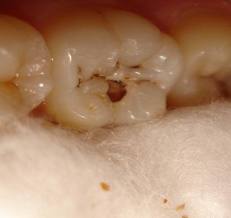SELECTION CONSIDERATIONS
In order to prevent the shadows cast onto the film by the grid from interfering with visualization of diagnostic detail, certain principles must be followed:
the lead should be as thin as possible to be consistent with adequate absorption of scattered radiation. The thinner the lead, the narrower the shadow it will produce on the film and the less visible it will be to the eye.
Also, the thinner it is the less absorption of primary radiation will be in the grid. BUT it must be noted that adequate absorption of scattered radiation is the function of the grid and lead must be thick enough to provide this function.
Monthly Archives: December 2011
Burning mouth syndrome
Burning mouth syndrome (BMS) is a painful, frustrating condition often described as a scalding sensation in the tongue, lips, palate, or throughout the mouth. Although BMS can affect anyone, it occurs most commonly in middle-aged or older women.
BMS often occurs with a range of medical and dental conditions, from nutritional deficiencies and menopause to dry mouth and allergies. But their connection is unclear, and the exact cause of burning mouth syndrome cannot always be identified with certainty. Continue reading
Radiographic Accessories Part 2
PARALLEL GRIDS
When strips are not progressively angulated but are perpendicular to the surface of the grid, the grid is termed “parallel” .
USED in fluroscopy & mobile imaging.
Continue reading
Osteoradionecrosis
Osteoradionecrosis (ORN) is a condition of nonvital bone in a site of radiation injury. ORN can be spontaneous, but it most commonly results from tissue injury. The absence of reserve reparative capacity is a result of the prior radiation injury. Even apparently innocuous forms of trauma such as denture-related injury, ulcers, or tooth extraction can overwhelm the reparative capacity of the radiation-injured bone. Continue reading
Peripheral giant cell granuloma
The peripheral giant cell granuloma has an unknown etiology, with some dispute as to whether this lesion represents a reactive or neoplastic process. However, most authorities believe peripheral giant cell granuloma is a reactive lesion. Continue reading
Radiographic Accessories Part 1
RADIOGRAPHIC ACCESSORIES
CONTENTS
GRIDS
FILTERS
COLLIMATORS
INTENSIFYING SCREENS
FILM HOLDERS
OTHER ACCESSORIES.
Pulp Therapy for kids
When caries in your child’s teeth has gone so deep that it has reached, or is near the pulp, your child will need more than just a normal filling to restore the tooth. If the infection from caries has reached the pulp, yet left untreated, the infection may spread causing more harm to your child. The pulp therapy that can be done on your child’s teeth can be divided into vital and non-vital technique:
Vital techniques: Continue reading
Mental nerve
Mental nerve is a general somatic afferent (sensory) nerve which provides sensation to the anterior aspects of the chin and lower lip as well as the buccal gingivae of the mandibular anterior teeth and the premolars. It is a branch of the posterior trunk of the inferior alveolar nerve, which is itself a branch of the mandibular division of the trigeminal nerve (CN V). The nerve emerges at the mental foramen in the mandibula, and divides beneath the Depressor anguli oris muscle into three branches: Continue reading
Radiographic Appearance of Cysts Part 3 and Scintigraphy
Nonodontogenic Cysts
NASOPALATINE DUCT CYST
Synonyms
Nasopalatine canal cyst
Incisive canal cyst
Nasopalatine cyst
Median palatine cyst
Median anterior maxillary cyst
Pros & Cons of Tooth Extractions
When faced with an aching tooth, the first thing that comes to mind is to pull the miserable tooth out. However depending on the cause of the toothache, tooth extraction is not the only way out of the pain. There are many causes of toothache and there is a chance that the aching tooth could be saved. Continue reading

